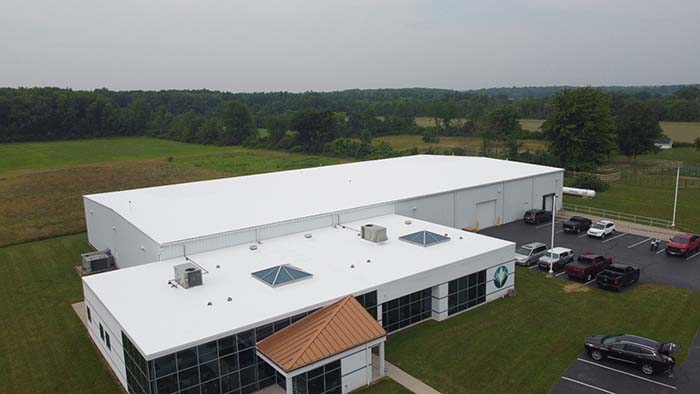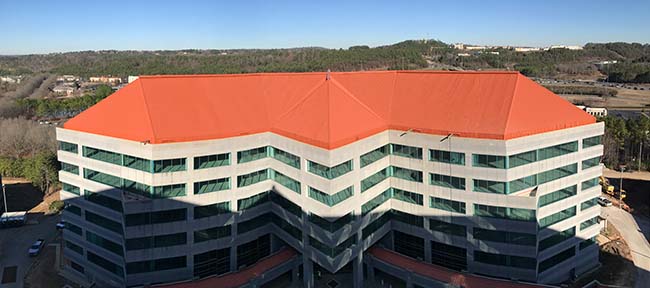Summary: If your TPO roof is too reflective, you can add a grey-colored roof coating system over top. Doing so will not only eliminate reflectivity, but it’ll give you a sustainable and seamless roofing membrane that’s made for long-term cost benefits.
Let’s say that you own a large hotel that’s 15 stories up. Let’s also say that you have multiple roofs, ones where the people on the 13th floor can see.
The last thing you probably thought of was…if I install this white TPO roof here, would it blind the residents looking at it from above?
And even if it did cause a minor disturbance, would I hear enough complaints to where I actually needed to do something about it?
To the property manager that reached out to us last month….the answer is Yes!
In this article, you’ll learn:
- What an elastomeric roof coating system is?
- What colors do they come in?
- What is the process for getting them installed?
- How much do roof coating systems cost?
- Besides reducing reflectivity, what other benefits do coating systems have?
And just so you know we aren’t blowing smoke, West Roofing Systems has been solving commercial roofing issues since 1979. Every article written has been edited and finalized by a roofer, salesman, or owner with more than 30 years in the field.
Let’s get rolling!
The main point of the article is that if your TPO roof is too reflective, your best option is to install an elastomeric coating over it.
What is an elastomeric roof coating system?

The easiest way to explain is that elastomeric coating systems are basically a very thick coating that gets rolled or sprayed onto an existing roof system.
Elastomeric means that the coating is engineered to expand and contract with the roof and not lose any performance. Commercial roofs heat up during the day and cool down during the night.
Acrylic, silicone, and urethanes are all “elastomerics” that are used for commercial roofing. Since we’ve been around since 1979, we’ve found that silicones are the best bang for the buck in terms of performance, product yield, and price.
What colors do roof coatings come in?
Roof coatings come in any color you want. Here’s a photo of Colonnade Towers in Birmingham, Alabama:

Colonnade was known for being the “building with the red roof” in Birmingham, so they wanted to keep their reputation when installing a coating system.
Most building owners choose white or grey though.
White if you’d like to maximize reflectivity, a light grey if you want great reflectivity.
But if you’re known as the “big, blue building”, any of the top coating manufacturers can make that happen.
What is the process for getting a coating system installed over a TPO roof?
The first step is a pre-job inspection. This is to make sure the TPO roof is a good candidate for a coating system. To be eligible, three things must happen:
1 – The TPO seams must be in good condition
2 – The roof has had to at least have annual maintenance
3 – Less than 25% of insulation is wet
If any of these three aren’t right, going with a coating system may not be your best bet. A complete tear-off might be a better option.
But let’s say your TPO roof passed, what’s next.
The first step to installation is to remove all the surface contaminants that can interfere with the coating’s proper adhesion. This is done through power washing at a minimum of 2500 PSI.
A rinseable cleaner wash may be used in tandem with power washing.
Next, the entire roof will be primed with a manufacturer’s suggested type of single-ply primer.
The next step is to reinforce the seams. This is done by installing a heavy coat of silicone over the seams (usually 12 inches wide), then embedding a polyester mesh into the wet coating, then encapsulating the mesh with another heavy coat of coating letting the area dry overnight.
Then the base coat of coating is applied. Then the topcoat is applied.
- For a 10-year warranty, the roof will receive a thickness level of 20 mils of coating.
- For a 15-year warranty, the roof will receive a thickness level of 25 mils of coating.
- For a 20-year warranty, the roof will receive a thickness level of 30 mils of coating.
How much do roof coating systems cost?
As of Summer 2021, the cost was around $2 to $4 per square foot. But recently, due to product and labor shortages and logistic delays, the cost has been around double.
I know it’s terrible for everyone involved, especially a building owner who has a good-conditioned roof who wants to get the roof under a new warranty.
Besides the variables that no one can control, what other factors make the cost go up or down?
Amount of tear-off
No coating system can (or should) be installed over wet insulation. The more wet insulation that’s identified and replaced, the higher the cost will be.
Length of warranty
A 20-year warranty uses about 50% more coating than a 10-year warranty. More product is going to increase the cost of the project.
Ease of roof access
If your roof is a high-rise, very close to other buildings, has a high slope, or is difficult to maneuver around, it can be more costly than a low, flat roof.
Distance to the roofing contractor
If your building is right down the street from the roofing contractor, your project will be less costly than one that’s 150 miles away.
Size of your roof
Every roof has safety setup, product deliveries, inspections, etc. A roofing contractor can be more cost-effective per square foot by working on a larger project. This is similar to buying a 24-pack of paper towels versus buying them individually. Which one will cost less per paper towel?
Besides reducing reflectivity, what other benefits do coating systems have?
There are many benefits that a roof coating system can offer a building owner.
New warranty
When you install a coating system, you can get a new warranty from the roofing contractor, or the manufacturer of the coating. The length of the warranty is usually 10-20 years.
Renewable
Say you get a new coating system installed over your existing TPO roof and you choose the 10-year warranty option. Your roof will have a coating thickness of 20 mils.
At year 10, 7-8 mils of coating may be remaining.
At this time, a roofing contractor will power wash the roof clean, make minor repairs and bring the coating to 20 mils of thickness again.
A new 10-year warranty can be granted.
It’s that simple!
Seamless membrane
Seams on a TPO roof can lose adhesions and create a water entry point. When you install a roof coating system, the seams are reinforced and covered, leaving behind a completely seamless roofing system.
Cost-effective long-term
When a roof coating system naturally wears away, you can recoat it (explained above) instead of tearing it all off like other roofing systems need to do.
This saves lots of money paying for the tear-off, transporting all the materials to a landfill, and then installing the new system.
A recoat costs 1/3 to ½ of the original installation. To tear off and install a new roofing system, the costs will be 100% of the original installation.
Conclusion
Hopefully, after today, you learned that you could reduce the reflectiveness of your TPO roof by adding a light-colored grey overtop.
Adding a coating system has other benefits, such as renewability, low lifetime costs, and it creates a seamless membrane.
West Roofing Systems has been in commercial roofing since 1979. In many cases, a building owner will have a TPO roof that needs repaired, restored, or completely removed. After an inspection, the most cost-effective solution can be recommended.

